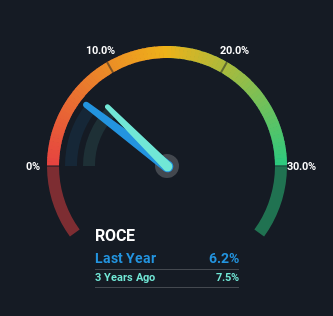- China
- /
- Construction
- /
- SHSE:600528
Returns On Capital Signal Tricky Times Ahead For China Railway Hi-tech Industry (SHSE:600528)

If we want to find a potential multi-bagger, often there are underlying trends that can provide clues. Amongst other things, we'll want to see two things; firstly, a growing return on capital employed (ROCE) and secondly, an expansion in the company's amount of capital employed. Ultimately, this demonstrates that it's a business that is reinvesting profits at increasing rates of return. In light of that, when we looked at China Railway Hi-tech Industry (SHSE:600528) and its ROCE trend, we weren't exactly thrilled.
Understanding Return On Capital Employed (ROCE)
If you haven't worked with ROCE before, it measures the 'return' (pre-tax profit) a company generates from capital employed in its business. To calculate this metric for China Railway Hi-tech Industry, this is the formula:
Return on Capital Employed = Earnings Before Interest and Tax (EBIT) ÷ (Total Assets - Current Liabilities)
0.062 = CN¥1.7b ÷ (CN¥63b - CN¥36b) (Based on the trailing twelve months to June 2024).
Thus, China Railway Hi-tech Industry has an ROCE of 6.2%. On its own that's a low return on capital but it's in line with the industry's average returns of 5.7%.
See our latest analysis for China Railway Hi-tech Industry

While the past is not representative of the future, it can be helpful to know how a company has performed historically, which is why we have this chart above. If you want to delve into the historical earnings , check out these free graphs detailing revenue and cash flow performance of China Railway Hi-tech Industry.
What The Trend Of ROCE Can Tell Us
When we looked at the ROCE trend at China Railway Hi-tech Industry, we didn't gain much confidence. To be more specific, ROCE has fallen from 9.2% over the last five years. Meanwhile, the business is utilizing more capital but this hasn't moved the needle much in terms of sales in the past 12 months, so this could reflect longer term investments. It may take some time before the company starts to see any change in earnings from these investments.
On a separate but related note, it's important to know that China Railway Hi-tech Industry has a current liabilities to total assets ratio of 57%, which we'd consider pretty high. This effectively means that suppliers (or short-term creditors) are funding a large portion of the business, so just be aware that this can introduce some elements of risk. Ideally we'd like to see this reduce as that would mean fewer obligations bearing risks.
The Key Takeaway
In summary, China Railway Hi-tech Industry is reinvesting funds back into the business for growth but unfortunately it looks like sales haven't increased much just yet. And in the last five years, the stock has given away 15% so the market doesn't look too hopeful on these trends strengthening any time soon. Therefore based on the analysis done in this article, we don't think China Railway Hi-tech Industry has the makings of a multi-bagger.
If you want to continue researching China Railway Hi-tech Industry, you might be interested to know about the 1 warning sign that our analysis has discovered.
While China Railway Hi-tech Industry may not currently earn the highest returns, we've compiled a list of companies that currently earn more than 25% return on equity. Check out this free list here.
New: AI Stock Screener & Alerts
Our new AI Stock Screener scans the market every day to uncover opportunities.
• Dividend Powerhouses (3%+ Yield)
• Undervalued Small Caps with Insider Buying
• High growth Tech and AI Companies
Or build your own from over 50 metrics.
Have feedback on this article? Concerned about the content? Get in touch with us directly. Alternatively, email editorial-team (at) simplywallst.com.
This article by Simply Wall St is general in nature. We provide commentary based on historical data and analyst forecasts only using an unbiased methodology and our articles are not intended to be financial advice. It does not constitute a recommendation to buy or sell any stock, and does not take account of your objectives, or your financial situation. We aim to bring you long-term focused analysis driven by fundamental data. Note that our analysis may not factor in the latest price-sensitive company announcements or qualitative material. Simply Wall St has no position in any stocks mentioned.
About SHSE:600528
China Railway Hi-tech Industry
Manufactures and sells infrastructure construction equipment worldwide.
Adequate balance sheet second-rate dividend payer.
Market Insights
Community Narratives



